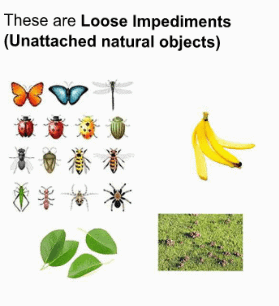
In the first article in our series on Golf Rules Made Easy, we looked at the importance of reading a club’s local Rules before you tee off, the definitions which define many aspects you will encounter as well as the first principle when you need to apply a Rule: In which area of the course is the ball lying? The answer to this question will determine which Rule(s) will be applicable.
The Western Province Golf Referees’ Association has, over a period of 5 years collected all the rulings our referees were involved in and it is not surprising to find that in about 88% of the cases, the rulings were about taking relief and dropping the ball – whether for a free drop or a penalty drop. Taking relief somewhere on the course is the aspect most club golfers will often encounter when playing – we will thus start by looking at all these instances where a player may take relief.
I know we all try our best when playing a shot, but I am often reminded about what Winston Churchill once said about golf: “There is only one problem with golf – the ball goes exactly where you hit it!”.
The 88% of cases mentioned above is linked to 5 Rules only and by exploring these Rules in depth, we will be able to help ourselves (and our fellow-competitors!) most of the times. But knowing the Rule applicable will not only help you to proceed on the course, but you will also know all the possible options that a Rule allows – and you can then choose the option that will best suit you to play your next shot!
I will discuss the 5 Rules in hopefully easy to understand terms, with examples, in the next few articles, but you may want to read up on the Rules to see the official versions. The Rules are: Rule 15 (Loose impediments and Movable Obstructions); Rule 16 (Abnormal Course Conditions); Rule 17 (Penalty Areas); Rule 18 (Ball Out of Bounds, Lost ball, Stroke and Distance); Rule 19 (Unplayable Ball).
Furthermore, Rules 15 and 16 gives you FREE relief in dealing with the situation your ball is in, while you get penalty relief when dealing with Rules 17, 18 and 19.
We can further split the free relief in 2 categories – under Rule 15 you leave your ball on the course and only remove any Loose Impediments or Movable Obstructions that may hinder you, while under Rule 16 (Abnormal Course Conditions) you pick up your ball and drop it away from the course condition to take relief (because we cannot e.g. move a tar road away from the ball!) We will discuss everything about Rule 16 in later articles.
Now let’s look at the basic principles applicable to Rule 15 that allows you to remove loose impediments or movable obstructions should it affect your play. (There are always some exceptions or exclusions, but we will focus on the basic things that normally happens on a course during play.)
We must firstly confirm what a Loose Impediment and a movable Obstruction is to know how to proceed when we find it on the course. I have mentioned in the first article that one will need to look at the Definitions in the Rule book to ensure that you understand what a Rule is actually referring to when it uses certain terms.
A Loose Impediment is defined as any unattached (“loose-lying”) natural object that you will find on a course – these objects are all nature-related (parts of the course related to “nature”) and is described as stones, loose grass, leaves, sticks, branches, dead animals, worms and insects and clumps of soil. As you can see, the list refers to everyday objects you will find in any natural environment where leaves will fall, small twigs may drop from trees, etc. It is thus products of nature (as opposed to Movable Obstructions).


A Movable Obstruction, on the other hand, is an artificial object (a product made by a human) and can be easily removed from its spot (otherwise it will be an immovable obstruction). This object is not part of nature as a human actually made it and placed it on the course – you do not find it naturally there. These will include stakes, distance markers, a bottle lying on the course, a piece of paper, etc. The only 2 requirements to be met is that it must be artificial (man-made) and should be easily removable.
For most part, Rule 15 treats Loose Impediments and Movable Obstructions exactly the same:
+ You may remove them for no specific reason at all. You can take it away near your ball, your stance or even when it is in your way a few meters ahead of you. You may thus “clean” around your ball or even take a stake away in the distance should you worry that your ball may hit it.
+ You may remove it anywhere on or off the course! This was one of the biggest changes in this Rule as of 2019. You may now remove it anywhere – even in bunkers and penalty areas! You may even remove say a branch lying Out of Bounds and your ball is in bounds and you feel the branch is interfering with your efforts.
+ You remove the Loose Impediment or Movable Obstruction for “free” (there is no penalty in doing so) and you can use your hands, feet, club etc to remove it (especially when taking Loose Impediments away).
There is however one big difference in the outcome should you remove either of the objects and in the process your ball should move (when ball at rest moved from its original spot and came to rest in new spot).
If you remove a Movable Obstruction and your ball moves during this process, you just replace the ball on the original spot and there is NO PENALTY. (I do believe that, as the man-made object should not naturally have been on the golf course as part of nature, you are not penalised should the ball move when you remove the object.)
But, if you remove a Loose Impediment and your ball moves during the process, you get a 1 SHOT PENALTY and must replace the ball on its original spot! (This differs from a movable obstruction as I believe that loose impediments are natural objects “dropped” by nature on the course and should you wish to remove it, you take the risk of a penalty or otherwise you should not “interfere” with nature.) I hope it make sense.
Please note that you must in both cases replace the ball on its original spot if it moved, otherwise you will get a 2 shot penalty for playing your ball from the Wrong Place – this is also applicable to the movable obstruction scenario even though you did not get a penalty initially for ball that moved. (If you receive a 1 shot penalty for ball that moved when you removed a loose impediment and now you did not replace it, the 2 shot penalty will come into effect. This ‘higher” penalty overrides the first one – you will thus only get a 2 shot penalty – and not 3 penalty shots.)
There is one further aspect re the Movable Obstructions I need to point out. You may sometimes find that you ball may be lying on top of a movable obstruction (e.g a piece of paper that was lying in the rough) – what do you do now? You may remove the obstruction, but your ball is not touching the course and we need to get it back on the course. You lift the ball, use the place where ball was at rest on top of the paper as the reference point and then drop the ball in the 1 club-length relief area on the course – we will discuss the relief areas and dropping when we get to look at Rule 14 later. (If the piece of paper was on the putting green, then you just place the ball on the green directly below where the ball was at rest on the paper.)
I trust that you will now be able to remove Loose Impediments and Movable Obstructions on (or off!) the course when you need to – a case where a Rule gives you an advantage/relief that you may use to your benefit!
Next time we will start exploring the other free relief scenarios, namely where you may pick up your ball and drop it away from a hindrance as regulated in Rule 16.
You are welcome to write to the editor to send in questions if you need more info on the rules or want to clear up something that may have happened during a round.
Happy golfing!





